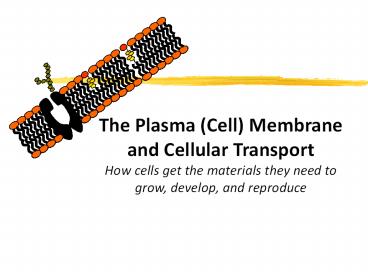The%20Plasma%20(Cell)%20Membrane%20and%20Cellular%20Transport - PowerPoint PPT Presentation
Title:
The%20Plasma%20(Cell)%20Membrane%20and%20Cellular%20Transport
Description:
Structure of the Cell Membrane Lipid Bilayer- 2 layers of phospholipids phosphate head is polar (water loving) fatty acid tails are non-polar (water fearing) ... – PowerPoint PPT presentation
Number of Views:225
Avg rating:3.0/5.0
Title: The%20Plasma%20(Cell)%20Membrane%20and%20Cellular%20Transport
1
The Plasma (Cell) Membrane and Cellular Transport
How cells get the materials they need to grow,
develop, and reproduce
2
What do all cells have in common?
- In order to grow, develop, and reproduce all
cells must be able to - remove waste
- bring in nutrients/water
- bring in oxygen
- What structure allows them to do this?
3
The Plasma(Cell) Membrane
- All cells have a cell membrane
- Cell Membrane Functions
- Controls what enters and exits the cell
- Maintains an internal balance called
HOMEOSTASIS - Provides protection and support for the cell
4
Structure of the Cell Membrane
- How do you build a barrier that keeps the watery
contents of the cell separate from the watery
environment?
- ? FATS ?
- ? LIPIDS ?
- Remember oil water dont mix!!
What substance do you know that doesnt mix with
water?
5
Structure of the Cell Membrane
- Lipid Bilayer- 2 layers of phospholipids
- phosphate head is polar (water loving)
- fatty acid tails are non-polar (water fearing)
- proteins embedded in the membrane
attracted to water
phosphate head
fatty acid tails
repelled by water
6
Cell Membrane Structure continued...
- Cell membranes have pores (holes) in them
- Selectively permeable Allows some molecules in
and keeps other molecules out
7
Cell Membrane Structure continued...
So what needs to get transported across the
membrane?
aa
H2O
lipids
salt
O2
sugar
waste
8
2 Types of Cellular Transport
- Passive Transport
- Cell uses NO energy
- Goes WITH the concentration gradient
- Active Transport
- Cell uses energy
- Goes AGAINST the concentration gradient
9
Types of Passive Transport Diffusion
- Diffusion the movement of molecules from an
area of high concentration to an area of low
concentration - Occurs until equilibrium is reached
- HIGH ? LOW
10
Types of Passive Transport Diffusion
- What molecules can get through the cell membrane
directly through simple diffusion? - fats and oils
- gases such as oxygen and carbon dioxide
O2
lipid
salt
waste
but what about other stuff?
aa
H2O
sugar
11
Types of Passive Transport Facilitated Diffusion
- Facilitated Diffusion type of passive transport
that allows substances to cross membranes with
assistance from special transport proteins - specific channels allow specific material in out
inside cell
sugar
aa
H2O
salt
outside cell
waste
12
Types of Passive Transport Diffusion
- Move from HIGH to LOW
fat
fat
fat
Which way will fat move?
inside cell
fat
fat
fat
LOW
HIGH
fat
outside cell
fat
fat
fat
fat
fat
fat
fat
13
Types of Passive Transport Facilitated Diffusion
- Move from HIGH to LOW through a channel
sugar
sugar
sugar
sugar
inside cell
sugar
sugar
LOW
Which way will sugar move?
HIGH
outside cell
sugar
sugar
sugar
sugar
sugar
sugar
sugar
14
Types of Passive Transport Osmosis
- Osmosis diffusion of water across a membrane
both simple diffusion and facilitated diffusion
15
Isotonic (Iso Same)
- The concentration of water molecules is the
same inside and outside the cell. - Water molecules will move across the membrane
at the same rate in both directions - NO NET MOVEMENT
16
Hypertonic (Hyper Above)
- Hypertonic solution high solute/ lower water
on outside - Water molecules will move out of the cell and
the cell shrivels - Plant cells will lose Turgor Pressure ( the
pressure water molecules exert on the cell wall) - Called plasmolysis
17
Hypotonic (Hypo Below)
- Hypotonic solution low solute/ high water on
outside - Water molecules will move IN the cell and the
cell will swell or possibly burst (cytolysis) - Plant cells will gain Turgor Pressure ( the
pressure water molecules exert on the cell wall) - Called deplasmolysis
18
What type of solution are these cells in?
C
B
A
Hypertonic
Isotonic
Hypotonic
19
Passive Transport Summary
- No energy required
- Molecules move from HIGH --gt LOW concentration
- Types of Passive Transport
- Diffusion
- Facilitated diffusion
- Osmosis
- isotonic vs hypertonic vs hypotonic
20
Cellular Transporta reminder
- Passive Transport
- Cell doesnt use energy
- Goes WITH the concentration gradient
- Active Transport
- Cell does use energy
- Goes AGAINST the concentration gradient
21
Active transport
- Cells may need molecules to move against
concentration hill - from LOW to HIGH using energy
- uses protein pump
energy
22
Transport summary
simplediffusion
facilitateddiffusion
energy
activetransport






























